
It could arrive with the new pitching coach.
Background and Inspiration.
In the last few seasons, the Diamondbacks changed what type of pitcher they acquired. Often, their pitching acquisitions could be described by three metrics, which I presented many times. Those metrics were:
- Whiffs/pitch greater than 13%.
- Strikeouts per batter faced greater than 25%
- Balls-in-play less than 26.5% of strikes thrown.
Perhaps a new emphasis will be placed on induced vertical break on four-seam fastballs. My enthusiasm for the idea was ignited by the first line in an article, “The Red Sox, you might have heard, have largely stopped throwing fastballs,…” Although they did NOT stop throwing fastballs, they threw less fastballs and the ones they threw were better (more vertical movement compared to the movement caused by gravity).
What would a Diamondbacks plan look like? The Red Sox, despite their pitching changes, did not come close to the playoffs. Certainly, the Diamondbacks plan would be different. A simple approach follows. For pitchers who have high velocity AND above average induced vertical break on their four-seam fastballs, their message would be well done and keep going that direction. For pitchers who lack those characteristics AND who frequently throw four-seam fastballs (some Diamondbacks pitchers do not throw many four-seam fastballs), the message would be either increase your induced vertical break, or pitch less of them.
If a new emphasis happens, my writing will often include a new metric: induced vertical break.
Two Assumptions.
The Diamondbacks like having different types of pitchers; and they will NOT attempt to change every pitcher. Instead, those who allow the most home runs and most hits will be their focus.
The Diamondbacks will implement two approaches: one approach for starting pitchers and one approach for relief pitchers. The data led me to conclude that that most important factor was different for the two types of pitchers.
Dividing pitchers into two groups: those to leave alone and those to change.
Because we are looking at induced vertical break, the first group to leave alone are those who were above-average in that measure: Nelson, McGough, Vieira, Mena, Gallen, and Allen.
The next group to think about carefully, and likely leave alone are those with an above-average ERA last season. That adds the following names: Diaz, Ginkel, Jarvis, Kelly, Mantiply, Martinez, Puk, and Thompson.
Let’s look at the remaining pitchers. For each pitcher, their percentage of fastball pitches was compared to their percentage of homers and hits that happened on fastball pitches. That comparison resulted in two groups of pitchers. One group had fewer homers and one group had more homers. Those two groups are shown in the following two tables.
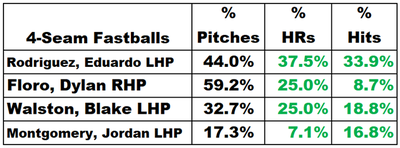
2024 Season. The remaining pitchers whose 4-seam fastballs are not an obvious problem. Data from Baseball Savant.
One conclusion is that better four-seam fastballs may not fix every pitcher, such as Jordan Montgomery. Perhaps some pitchers in the first table can improve in a manner not related to induced vertical break.
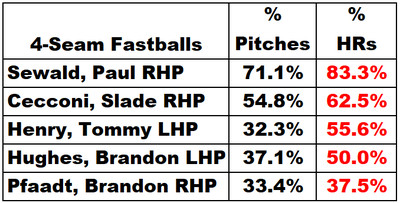
2024 Season. Remaining pitchers who could benefit from better 4-seam fastballs. Data from Basebal Savant.
Perhaps pitchers in the second table could benefit from an increased induced vertical break in their 4-seam fastballs.
Relief Pitchers.
To my surprise, something impacted relief pitcher ERA more than induced vertical break. The following table shows that for relief pitchers who throw four-seam fastballs, pitch velocity had a big impact. The impact is shown in the following scatterplot.
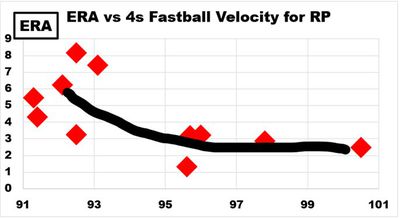
2024 Season. Velocity in MPH. Data from Baseball Savant.
The plot indicates when the average velocity falls below a critical speed, the pitcher’s ERA rises quickly.
Starting Pitchers.
For starting pitchers who throw four-seam fastballs, induced vertical break impacted ERA. The impact is shown in the following scatterplot.
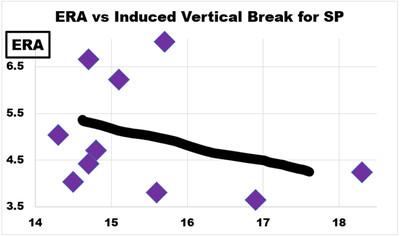
2024 Season. IVB in inches. Data from Baseball Savant.
Small changes may be better than big changes.
When comparing 2024 to 2023, starting pitchers who either made a 10% reduction in their percentage of four-seam fastballs, or made any increase in their percentage of four-seam fastballs, had higher ERA than those who did not change (the one exception was Cecconi who made a small 4% reduction and yet had a high ERA). My conclusion is that doing any change except a relatively small reduction in four-seam fastballs worsens the pitcher’s performance. Details are in the following graph.
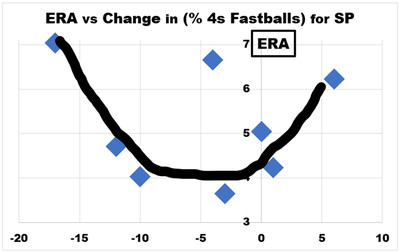
2024 Season. Data from Baseball Savant.
Which two pitchers had elite IVB?
A hypothesis is that a combination of high velocity and high induced vertical break results in elite pitching. The following chart shows two characteristics of the Diamondbacks pitchers’ four-seam fastballs. Going from left to right, you see three increasing levels of induced vertical break (IVB). Going from bottom to top, you see three increasing levels of velocity.
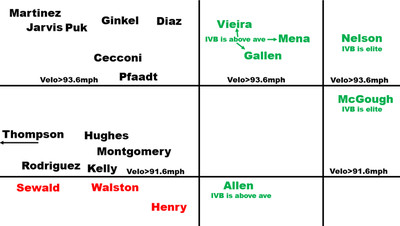
2024 Season. Data from Baseball Savant.
Interestingly, there were no Diamondbacks pitchers in the middle square. Perhaps that can be explained that instead of being middle of the spectrum for every aspect, a path to success is more often found in excelling in one or more aspects.
Summary.
A new plan for Diamondbacks pitching could focus on induced vertical break for four-seam fastballs.
After excluding pitchers with above-average induced vertical break and excluding pitchers with better-than-average ERAs, the remaining pitchers could be divided into two groups – those to leave alone and those who could benefit from better induced vertical break.
For relief pitchers, average velocity of four-seam fastballs impacted their ERA.
For starting pitchers, induced vertical break impacted their ERA.
Small changes in percentage of four-seam fastballs may be better than large changes.
Last season, two Diamondbacks pitchers had elite induced vertical break – Ryne Nelson and Scott McGough.
